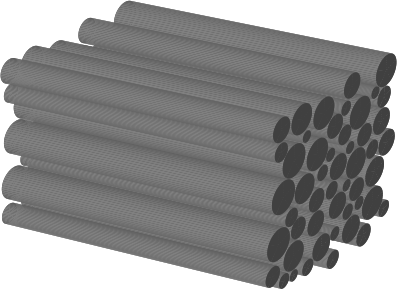Basic sums and the effective conductivity of composites¶
Consider the effective conductivity of polydispersed fiber inclusions of conductivity \(\lambda_f\) of different sizes randomly embedded in a matrix of conductivity \(1\) (see Fig. 1).
A cross–section of such composite is considered to be the periodic two–dimensional lattice \(\mathcal{Q}\), defined by complex numbers \(\omega_{1}\) and \(\omega _{2}\) on the complex plane \(\mathbb{C}\). The \((0,0)\)-cell is introduced as the parallelogram \(Q_{(0,0)}:=\{z=t_{1}\omega_{1}+t_{2}\omega_{2}:-1/2<t_{j}<1/2\;(j=1,2)\}\) (see Fig. 2).
The lattice \(\mathcal{Q}\) consists of the cells \(Q_{(m_{1},m_{2})}:=\{z\in \mathbb{C}:z-m_{1}\omega_{1}-m_{2}\omega _{2}\in Q_{(0,0)}\}\), where \(m_{1}\) and \(m_{2}\) run over integer numbers.
Inclusions are modelled by \(N\) non-overlapping disks of different radii \(r_j\) (\(j=1,2,3,\ldots,N\)). Thus, the total concentration of inclusions equals
Let \(r=\displaystyle\max_{1 \leq j \leq N}r_j\) and introduce the constants
describing polydispersity of inclusions. V.Mityushev [2] obtained the closed form representation of the effective conductivity (see also [3])
where
is the Bergman’s contrast parameter and the constants \(B_q\) are given by the following theorem, as linear combinations of basic sums (defined later in this section).
Theorem [1] The algorithm for generating the symbolic representations of the coefficients \(B_q\) takes the form of a recurrence relation of the first order:
where \(\beta\) is the substitution operator modifying every basic sum in \(B_{q-1}\) according the transformation rule:
Consider a set of points \(a_k\) \((k= 1, 2,3,\ldots, N)\) in the cell \(Q_{(0,0)}\). Let \(n\) be a natural number; \(k_0, k_1\ldots, k_n\) be integers from 1 to \(N\); \(k_j\geq 2\). Let \(\mathbf{C}\) be the operator of complex conjugation. The following sums, encountered in (3) and (4), were introduced by V.Mityushev:
where \(\eta=\sum_{j=1}^N\nu_j\) and \(\delta ={\frac{1}{2}\sum^n_{j=1}p_j}\). Functions \(E_k\) (\(k=2,3\ldots\)) are Eisenstein functions corresponding to the two-periodic cell \(Q_{(0,0)}\) (see section on Eisenstein functions), and the superscripts \(t_j\) \((j=0,1,2\ldots,n)\) are given by the recurrence relations
The sum (5) is called the basic sum of the multi-order \({\mathbf p}=(p_{1},\ldots,p_{n})\). Hereafter, the superscripts for basic sum are omitted for the purpose of conciseness. In addition, following we have \(t_n=1\). From the above definitions we see that every coefficient \(B_q\) (\(q=1,2,3, \ldots\)) forms the linear combination of basic sums. All basic sums included in the coefficient \(B_q\) are called basic sums of order \(q\).
In case of the composite modelled by \(N\) identical disks, where \(\nu_j=1\) (\(j=1,2,3,\ldots,N\)), basic sums \(e_2\) and \(e_{2,2}\) take the following forms:
References
| [1] |
|
| [2] |
|
| [3] |
|

